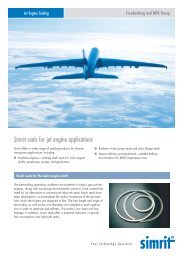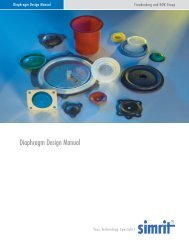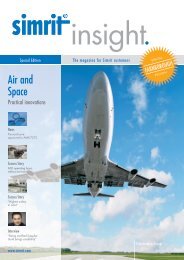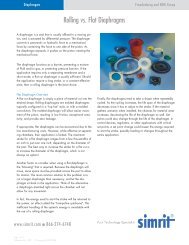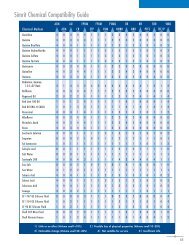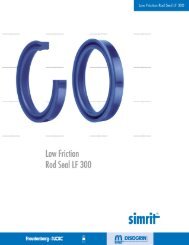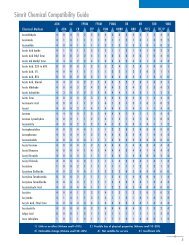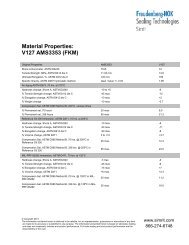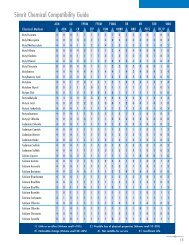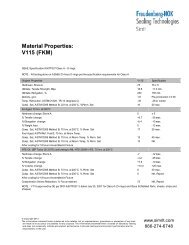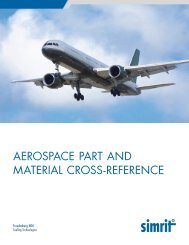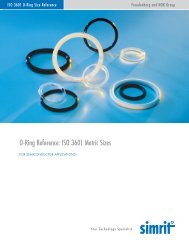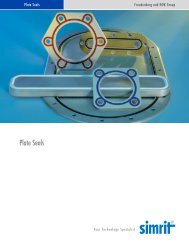Simrit Insight
Simrit Insight
Simrit Insight
You also want an ePaper? Increase the reach of your titles
YUMPU automatically turns print PDFs into web optimized ePapers that Google loves.
insight.<br />
No 1 | 2009<br />
The magazine for <strong>Simrit</strong> customers<br />
<strong>Simrit</strong> and<br />
Honda<br />
Synergy in Brazil<br />
Materials<br />
Nano technology improves<br />
seal performance<br />
Materials<br />
FKM for harsh<br />
environments<br />
Applications<br />
Multi-purpose<br />
kitchen aid<br />
Innovations<br />
FEA for O-ring form,<br />
fit, and function<br />
www.simrit.com<br />
Freudenberg and NOK Group
Editorial<br />
News | Contents<br />
David R. Monaco<br />
<strong>Simrit</strong> Americas<br />
In today’s economy, having stable and trustworthy suppliers is more important to your<br />
success than ever. Reliable partners help you achieve your goals of top of the line product<br />
performance and complete customer satisfaction. <strong>Simrit</strong>, as your technology specialist,<br />
offers a diverse range of technologies and can give you advice regarding your application<br />
issues right from the start. Ground floor project involvement has led to many innovations<br />
around the world, as illustrated in the following articles.<br />
This issue of <strong>Simrit</strong> <strong>Insight</strong> focuses on technological advancements our materials experts have<br />
been working on, from nano technology for improved seal performance to new FKM compounds<br />
for truly harsh environments. The articles highlight various applications that require<br />
innovative seal design and creative problem solving at both the customer and supplier levels.<br />
I hope these articles will give you plenty of new ideas for your own developments and<br />
that they will lead to productive discussions with your dedicated <strong>Simrit</strong> engineers and sales<br />
team. As always, you can count on us to be your sealing partner through these challenging<br />
economic times.<br />
Yours sincerely,<br />
David R. Monaco<br />
<strong>Simrit</strong> Americas<br />
Tillsonburg, Ontario, facility now UTC Supplier Gold<br />
<strong>Simrit</strong>’s Tillsonburg, ON, Canada site<br />
has recently been awarded UTC’s<br />
(United Technologies) Supplier Gold<br />
Status. Our site is one of the first UTC<br />
suppliers to be approved to Supplier<br />
Gold. UTC awards this title to<br />
companies that are “best-in-class”<br />
in delivery, quality, customer support,<br />
and lean practices.<br />
TechDay at MWM International<br />
On February 17th, <strong>Simrit</strong> hosted a TechDay at MWM International’s<br />
site in São Paulo, Brazil. The training topic was Valve Stem Seals, an<br />
important product for the Brazilian market. Ademir Oliveira Antunes was<br />
the <strong>Simrit</strong> engineer who gave the training, which was attended by over<br />
40 participants. <strong>Simrit</strong> focused on the qualities and benefits of valve stem<br />
seals and on their applications, explaining in detail the advantages of<br />
this product. Discussions focusing on how <strong>Simrit</strong>’s technology could help<br />
the company in the development of future projects were led by MWM’s<br />
group on projects relating to sealing.<br />
New <strong>Simrit</strong> literature is now available<br />
on www.simritna.com/brochures<br />
Update your information on <strong>Simrit</strong> products and technology with these<br />
new brochures and flyers from our website:<br />
Thermoplastics Seals and Components flyer<br />
Metal OD Radial Shaft Seals brochure<br />
O-Ring Quality Assurance Standards brochure<br />
Semiconductor Sealing Applications Technology brochure<br />
6 new diaphragm product flyers<br />
RFN Treatment flyer<br />
<strong>Simrit</strong> UL Listed Compounds flyer<br />
Diaphragm Design Manual<br />
Contents<br />
Cover story 3–4<br />
<strong>Simrit</strong> and Honda<br />
Synergy in Brazil<br />
Materials 6<br />
<strong>Simrit</strong> compound N459<br />
a boon to air safety<br />
Applications 8<br />
Cool O-rings<br />
in hot environments<br />
Materials 9–10<br />
Nano technology improves<br />
seal performance<br />
Materials 11–12<br />
FKM for truly harsh<br />
environments<br />
Applications 13–14<br />
Tough seals for tough<br />
conditions<br />
Applications 15–16<br />
Multi-purpose<br />
kitchen aid<br />
Imprint<br />
<strong>Simrit</strong> ® insight is the magazine for <strong>Simrit</strong> customers. Publisher: Freudenberg–NOK General Partnership, 47690 East Anchor Court, Plymouth, Michigan 48170-2455 Responsible: Tim Lomax<br />
Phone: 734-354-5336 E-Mail: tim.lomax@simrit.us Project Management: Katharina Bergman Phone: 734-354-5586 E-mail: katharina.bergman@simrit.us Internet: www.simrit.com Editorial &<br />
Design: Frank Trurnit & Partner Verlag GmbH and Leidenthal Design. Reprinting or reproduction only with approval of the publisher.<br />
Innovations 17–18<br />
FEA for O-ring form,<br />
fit, and function<br />
01 <strong>Simrit</strong> insight 01|2009<br />
<strong>Simrit</strong> insight 01|2009 02
Application<br />
+ + + Cover story—<strong>Simrit</strong> and Honda: Synergy in Brazil + + + + + + Cover story—<strong>Simrit</strong> and Honda: Synergy in Brazil + + +<br />
Cover Story<br />
In brief<br />
SIMRIT and HONDA: Maximum Synergy in<br />
Quality and Technology<br />
Honda’s Brazilian operation<br />
and <strong>Simrit</strong> have been partners<br />
for about 30 years. <strong>Simrit</strong><br />
presently supplies 16 products<br />
(oil seals and O-rings included)<br />
for Honda’s motorcycles.<br />
Such a long-lasting partnership<br />
is made possible by shared<br />
values: investment in new<br />
technologies, commitment<br />
to maximum quality, and full<br />
customer satisfaction.<br />
In 2008 <strong>Simrit</strong> supplied<br />
approximately five million oil<br />
seals and 50 million O-rings<br />
for the Honda motorcycles<br />
produced in Brazil.<br />
A sales leader in the two-wheel segment, Honda was one of the<br />
first companies to import and manufacture motorcycles in Brazil.<br />
It began operating in the country in 1971 and, five years later,<br />
it was producing locally. Today, Honda offers 14 motorcycle models<br />
in the Brazilian domestic market and exports to over 70 countries.<br />
Since 1997, it has been producing automobiles too.<br />
<strong>Simrit</strong>’s spring-energized<br />
seals are integral to<br />
Honda’s motorcycle<br />
production in Brazil.<br />
For questions please contact<br />
Adriano.Vargas@simrit.com.br<br />
High technology in the heart of the<br />
Amazon rainforest<br />
Honda’s motorcycle plant is located in<br />
the heart of the Amazon rainforest, in<br />
the city of Manaus, capital of the largest<br />
Brazilian state—Amazonas—with over<br />
1.5 million square meters in area.<br />
Manaus sits on the Negro River, the<br />
main affluent of the Amazon River, and<br />
enjoyed a major development period<br />
between 1900 and 1920 as the major<br />
rubber producing center of the world’s<br />
automobile industry.<br />
Presently, Manaus houses one of the<br />
largest industrial parks of Latin America,<br />
with over 400 companies operating in the<br />
Manaus Free Zone, a free-trade import<br />
and export area with special tax incentives.<br />
The main Brazilian electronic industries<br />
are also concentrated in this region.<br />
Continuous investment in technology is<br />
Honda’s main differentiator to maintain<br />
its leadership in the Brazilian twowheel<br />
market. Its industrial park in<br />
Manaus has a complete product<br />
development structure and is certified<br />
according to the world’s major quality<br />
and environmental standards, such<br />
as ISO 9002 and ISO 14001. The<br />
plant employs 9,500 people, produces<br />
around 6,000 units/day and, in 2008,<br />
reached the historical mark of 12 million<br />
motorcycles manufactured since operations<br />
began.<br />
A big hit in small displacement<br />
In 2008, more than 1.45 million Honda<br />
motorcycles were sold in Brazil, with<br />
the CG 150i Titan standing out. A sales<br />
leader for over 30 years now, the CG<br />
150i Titan motorcycle reached the mark<br />
of 462 thousand units sold.<br />
Small displacement motorcycles (up to<br />
150 cc) are a sales hit in the country.<br />
They are sold at an average price of<br />
US$2,800 or, in monthly installments of<br />
around US$47. Strong, economic, and<br />
easy to maintain, they hold an 85%<br />
share of the Brazilian two-wheel fleet.<br />
They are ideal for the busy traffic of<br />
large urban centers and serve as a<br />
practical and inexpensive<br />
alternative to horses in rural<br />
zones. In addition to the CG<br />
150i Titan, other top-selling<br />
Honda 100 to 150 cc motorcycles<br />
in Brazil include the<br />
BIZ 125, CG 125 Fan, CG<br />
150 JOB, CG 150 Sport,<br />
and Pop 100.<br />
In 2008, the Honda<br />
motorcycle plant employing<br />
9,500 people in Manaus,<br />
Brazil, reached the production<br />
milestone of 12 million units.<br />
The ideal sealing for Honda quality<br />
Since Honda began manufacturing<br />
motorcycles in Brazil in 1976, it has<br />
been important to source components<br />
from the best parts manufacturers in<br />
the country. For that reason, in the<br />
very first years of activities Honda<br />
established a partnership with<br />
Rubrasil, an automobile sealing<br />
products manufacturer, that was<br />
incorporated into the Freudenberg<br />
group and has evolved to become<br />
<strong>Simrit</strong> today.<br />
Today, <strong>Simrit</strong> oil seals and O-rings<br />
help Honda motorcycles win maximum<br />
consumer reliability. These parts<br />
are critical to the perfect operation and<br />
durability of motorcycles, preventing<br />
fluid leakage into the environment and<br />
reducing pollutant emissions.<br />
<strong>Simrit</strong> supplies 16 sealing items to the<br />
Honda motorcycles produced in Brazil<br />
—15 oil seals and one O-ring. <strong>Simrit</strong><br />
products seal the engine, clutch, gear-<br />
box, and wheels. The high technology<br />
of the items supplied, together with the<br />
fulfillment of delivery deadlines and<br />
efficient post-sale services, resulted in<br />
approximately 5 million oil seals and<br />
50 million O-rings being provided to<br />
Honda last year.<br />
The two top-selling motorcycles of the<br />
Brazilian market—Honda CG 150i<br />
Titan and Honda CG 125 Fan—rely on<br />
the quality of the <strong>Simrit</strong> oil seals for<br />
perfect sealing of the starter pedal,<br />
clutch shaft, gearbox shaft, driveshaft,<br />
starter motor, front brake panel, and<br />
rear hub cap.<br />
For over three decades now, the <strong>Simrit</strong><br />
and Honda partnership has been<br />
strengthened by the similarities between<br />
the two companies—the priority of<br />
continuous investment in new technologies,<br />
maximum product quality/performance/<br />
safety, and full customer satisfaction as<br />
their ultimate goal.<br />
03 <strong>Simrit</strong> insight 01|2009 <strong>Simrit</strong> insight 01|2009 04
Applications<br />
Materials section<br />
Expertise on the Flender test bench<br />
The Mechanical Drives business unit of Siemens AG is the leading provider for mechanical drive technology worldwide.<br />
Under the Flender brand, the business unit offers industrial gears and couplings for nearly all industrial<br />
applications. Siemens Mechanical Drives has been working with <strong>Simrit</strong> for quite some time for their lubricant selections.<br />
The operating reliability of gearboxes is<br />
not only the result of the dependability<br />
of the rotary shaft seals that are used.<br />
For the approval of lubricants in Flender<br />
gearboxes, the compatibility of the seals<br />
with the lubricants is crucial. To this end,<br />
both companies have worked together<br />
on projects to develop a comprehensive<br />
testing program known as the Flender<br />
Test. Against the backdrop of increasing<br />
life-cycle requirements for the entire<br />
system, this test scenario has now been<br />
revised with the goal of achieving a<br />
considerable improvement in the<br />
dependability of the test results. With<br />
the introduction of the Flender Test, the<br />
compatibility between the lubricant and<br />
the radial shaft seal has been greatly<br />
improved. The method has also proved<br />
a pioneer for new gearbox lubricant<br />
formulas. Siemens Mechanical Drives<br />
guarantees that a significant improvement<br />
in the operating reliability of the<br />
gearbox will be realized. The specifications<br />
of the enhanced Flender Test go<br />
beyond both the requirements of the<br />
static tests in accordance with DIN ISO<br />
1817 as well as requirements of the<br />
dynamic oil compatibility test based<br />
on DIN 3761.<br />
Combined expertise<br />
Over the course of an optimization<br />
process lasting about a year, <strong>Simrit</strong> and<br />
the Siemens business unit worked to<br />
further develop the current test specifications<br />
on a fundamental level. As a<br />
result, it was possible to significantly<br />
improve the correlation between the test<br />
results and the real life-cycle values of<br />
Flender gearboxes—<br />
greased with <strong>Simrit</strong>’s expertise<br />
the radial shaft seals. <strong>Simrit</strong>’s expertise<br />
in compatibility of sealing elements with<br />
lubricants and Siemens’ expertise in<br />
gearboxes were combined in the<br />
Flender Test. Both companies were able<br />
to improve the dependability of sealing<br />
systems. An additional step toward<br />
increased environmental compatibility<br />
was also made by incorporating<br />
lubricants from renewable resources<br />
into the test series.<br />
In brief<br />
The compatibility of lubricants with<br />
radial shaft seals is ensured via the<br />
Flender Test<br />
Project work between Siemens<br />
Mechanical Drives and <strong>Simrit</strong> offers<br />
technical and economic benefits<br />
Do you have any questions or<br />
suggestions Please contact<br />
Martin.Mueller@simrit.de<br />
Aircraft safety is tops with<br />
<strong>Simrit</strong> compound N459<br />
<strong>Simrit</strong> compound N459 meets all AMS-P-5510 requirements and bests the competition.<br />
N459 material shows excellent balance of performance properties for aircraft hydraulic systems<br />
With the safety and sustainability of air<br />
travel at risk if the quality and integrity<br />
of the sealing solutions are in question,<br />
many critical aerospace applications<br />
are dependent on the technology that<br />
seals them.<br />
<strong>Simrit</strong> has long been committed to<br />
providing the best in sealing solutions to<br />
the aerospace industry. This was recently<br />
reinforced when the company’s N459<br />
compound received Qualified Product<br />
Listed (QPL) status on AMS-P-5510-certified<br />
seals for aircraft hydraulic systems.<br />
Additionally, in a recent test performed<br />
by <strong>Simrit</strong> engineers, the N459 O-ring met<br />
all of the requirements of the specification.<br />
In contrast, two competitive seals failed<br />
in several areas, including two crucial<br />
areas of performance—compression set<br />
resistance in the application fluid and<br />
low-temperature flexibility as measured<br />
by TR-10.<br />
“We’re clearly pleased with the results,”<br />
said Dr. Bob Keller, materials development<br />
manager for <strong>Simrit</strong>. “Both of the<br />
competitive seals tested were qualified<br />
product listed on AMS-P-5510 and yet<br />
they did poorly in key performance<br />
areas. We are proud of our products<br />
and confident in our ability to provide<br />
customers with the best seals and<br />
materials in the aerospace industry.”<br />
The competitive testing examined the<br />
materials based on: original properties<br />
(hardness, 50 percent modulus, tensile<br />
strength, ultimate elongation and specific<br />
gravity); heat aging (change in hardness,<br />
change in tensile strength and change in<br />
ultimate elongation); immersion in liquid<br />
(change in hardness, tensile strength,<br />
ultimate elongation, change in volume,<br />
TR-10); compression set; and cold<br />
temperature resistance. <strong>Simrit</strong>’s N459<br />
O-ring outperformed its competition in<br />
nearly all tested properties.<br />
N459 was created with low-temperature<br />
flexibility to prevent leakage in sub-zero<br />
temperatures and at altitude. The elastomer<br />
material offers better resistance to<br />
high pressure and excellent resistance<br />
to red hydraulic fluids used in actuation<br />
systems. And unlike other products<br />
made to the AMS-P-5510 specification,<br />
<strong>Simrit</strong>’s N459 doesn’t corrode the<br />
mating metal fittings and components,<br />
and doesn’t bloom or discolor.<br />
<strong>Simrit</strong>’s N459 material, as well as several<br />
other innovative sealing technologies<br />
and products, will be on display at Paris<br />
Airshow Le Bourget’s 100th anniversary<br />
in France from June 15 to 21, 2009. Visit<br />
<strong>Simrit</strong> at our booth in Hall 3, Stand B11.<br />
In brief<br />
<strong>Simrit</strong>’s N459 compound<br />
received Qualified Product Listed<br />
(QPL) status on AMS-P-5510-certified<br />
seals for aircraft hydraulic systems.<br />
N459 O-ring outperformed its competition<br />
in nearly all tested properties<br />
Do you have any questions<br />
Please contact Robert.Keller@simrit.us<br />
05 <strong>Simrit</strong> insight 01|2009<br />
<strong>Simrit</strong> insight 01|2009 06
Products<br />
Applications<br />
Partnership in technology<br />
When developing dependable drive technologies, reliable partners are of utmost importance. In the case of<br />
German drive specialist Wittenstein, <strong>Simrit</strong> was involved early on in the reworking of the SP and TP drive<br />
series. A new wear-resistant elastomer has helped to improve service life.<br />
For companies like gearbox and drive<br />
specialist Wittenstein AG, who supply<br />
systems to nearly all branches of<br />
mechanical engineering, aviation and<br />
aerospace, the first priority is technological<br />
reliability. Wittenstein expects<br />
partners for whom dependable technologies<br />
are also a top priority and who<br />
can be integrated very early into development<br />
projects thanks to equal quality<br />
standards. “This ensures that high-quality<br />
products are developed to offer a maximum<br />
benefit to the customer,” explains<br />
Walter Lang, Head of Development for<br />
Drive Components at the Central Development<br />
department of Wittenstein AG.<br />
Early incorporation into projects<br />
As a specialist in sealing technology,<br />
<strong>Simrit</strong> was involved in the reworking of the<br />
SP and TP gearboxes from Wittenstein,<br />
beginning as early on as the initial<br />
design considerations. The goal of the<br />
project was to increase service life and<br />
reduce the running noise in gearboxes.<br />
<strong>Simrit</strong> also made suggestions early on<br />
to optimize the surface treatment of the<br />
In brief<br />
Collaboration between Wittenstein and<br />
<strong>Simrit</strong> in the reworking of two different<br />
gearbox series<br />
All competencies (lubricants and seals)<br />
were supplied from a single source<br />
Based on the excellent qualities of<br />
the radial shaft seals, Wittenstein<br />
products can be used for a broad<br />
range of applications<br />
Any questions or suggestions Please<br />
contact Andreas.Franke@simrit.de<br />
shafts and made a case for the use of a<br />
radial shaft seal made of the new wearresistant<br />
75 FKM 170055 elastomer.<br />
As a result, the wear rates and warm-up<br />
times of the sealing system were considerably<br />
improved. In specific terms, the<br />
new elastomer was 30 percent better<br />
than the industry standard. Use of the<br />
new material yielded considerably<br />
longer service lives for gearboxes, fewer<br />
defects and less downtime.<br />
Less downtime<br />
The new benefits not only strengthen<br />
the reputation of Wittenstein and its<br />
customers in a variety of industries, they<br />
also provide customers with tangible<br />
financial benefits. The systems now<br />
require maintenance less often. The<br />
low failure rates and downtimes improve<br />
the overall utilization ratio of the<br />
systems. “Thanks to the competent<br />
advice provided by <strong>Simrit</strong>, it was not<br />
only possible to improve the dependability<br />
of our products even more; now<br />
we can also include dependability<br />
Technical dependability<br />
is integral to gearboxes<br />
from Alpha Wittenstein.<br />
forecasts for seal technology used in our<br />
products,” says Volker Metzger, Head<br />
of Customer Service at Wittenstein AG.<br />
The open, constructive project work not<br />
only allowed for the achievement of<br />
project goals described here, in addition,<br />
a shared knowledge base was also<br />
established for future projects.<br />
Gearbox series SP—<strong>Simrit</strong><br />
collaboration was integrated<br />
early on beginning with<br />
the initial constructional<br />
considerations.<br />
Container ship travel is a time-dependent business, where downtimes can be very expensive.<br />
Cool O-rings in hot environments<br />
The sealing of turbochargers demands materials that can withstand high temperatures without being damaged.<br />
<strong>Simrit</strong> now supplies ABB Turbo Systems with 20 different types of O-rings made of temperature-resistant FKM.<br />
Exhaust gasses are waste products<br />
On the contrary! This resource simply<br />
has to be utilized. For example, exhaust<br />
from diesel or gasoline engines contains<br />
power that can, when used intelligently,<br />
unleash the true potential of these engines.<br />
Headquartered in the Swiss city of<br />
Baden, ABB Turbo Systems has been<br />
improving the performance of diesel<br />
and gasoline engines through its turbocharger<br />
technology for more than eight<br />
decades. The product range of the<br />
corporate division of ABB includes the<br />
right supercharger for each 2-cycle and<br />
4-cycle engine. And these superchargers<br />
are tailored to achieve efficient operation<br />
in the 500 kW to 25,000 kW power<br />
range. The exhaust of the engine is used<br />
by a turbine to drive a compressor<br />
which compresses air into the cylinder<br />
compartments, thus increasing the power<br />
of the engine. This principle allows the<br />
engine power to be increased by a factor<br />
of four as a result of supercharging—<br />
nearly 75 percent of the total power of<br />
an engine. The turbocharger is thus a<br />
central power element of an engine and is<br />
absolutely indispensable. If, for example,<br />
a container ship were to pull into port<br />
several days late due to a failed turbocharger,<br />
this could cost the shipping<br />
company a great deal of money. This<br />
failure could be caused by inconspicuous<br />
and cheaper components. If these are<br />
of inferior quality, the turbocharger can<br />
fail, resulting in higher costs. ABB Turbo<br />
Systems is therefore pleased with its<br />
partnership with <strong>Simrit</strong> which goes back<br />
more than ten years. Customers have had<br />
positive experiences with <strong>Simrit</strong>’s FKM<br />
seal elements used for high temperature<br />
ranges. The O-rings made of high<br />
temperature-resistant elastomer 75 FKM<br />
171978 are guaranteed to be oil-proof<br />
on both the exhaust side—even at a<br />
temperature of 250°C—as well as for<br />
the compressor air at 200°C.<br />
Longer service intervals<br />
Business with the high temperature<br />
resistant FKM mentioned above began<br />
A compressor plate with seal<br />
ring from <strong>Simrit</strong>.<br />
in 2004 with three different sizes of<br />
O-rings. Today, there are 20 different<br />
sizes. Because the installation situation<br />
does not permit any changes during<br />
operation, the O-rings must be adapted<br />
to the particular conditions present.<br />
Despite the ever increasing demands<br />
that result from increasing temperatures,<br />
it was possible to considerably increase<br />
the service intervals of the O-rings.<br />
Shippers, for example, can be sure that<br />
even after turbochargers have been<br />
operated for extended periods their<br />
containers will be delivered on time.<br />
In brief<br />
ABB turbochargers increase the<br />
power of a diesel or gasoline engine<br />
by a factor of four<br />
Turbochargers are used in all types<br />
of ships, in mining vehicles, diesel locomotives<br />
and power plants using diesel or<br />
gasoline engines<br />
<strong>Simrit</strong> provides custom high temperature<br />
resistant FKM O-rings for ABB turbochargers<br />
Any questions or suggestions<br />
Please contact Anton Schneider: as@simrit.ch<br />
07 <strong>Simrit</strong> insight 01|2009<br />
<strong>Simrit</strong> insight 01|2009 08
Materials<br />
Materials<br />
Nano technology yields large improvements<br />
RFN (Reduced Friction by Nanotechnology) is an innovative process to improve seal function and service life.<br />
<strong>Simrit</strong> now has more than eight years experience with these new treatment processes.<br />
High on the list of customer requirements<br />
are parameters such as “long service life,”<br />
“extended maintenance intervals,” and<br />
“low coefficients of friction.” Achieving<br />
these goals requires continuously adapting<br />
and modifying sealing components<br />
in various ways. One of the newest<br />
technologies available for improving<br />
sealing performance is surface transformation<br />
through RFN treatments.<br />
The challenge of seal surfaces<br />
Sealing components made of elastomeric<br />
materials can inherently have high<br />
surface energies (tackiness) and a high<br />
coefficient of friction (COF). Whenever<br />
an elastomeric seal makes contact with<br />
the mating component, the interface of<br />
the two surfaces can produce a “stiction”<br />
effect. This can be detrimental when the<br />
contact is intermittent. Here is where<br />
Reduced Friction by Nanotechnology<br />
(RFN) becomes a factor for improving<br />
seal performance. Applications that<br />
require low “stiction” and long service<br />
life such as valve sealing components<br />
and diaphragms can greatly benefit<br />
from RFN treatments. Sealing component<br />
surfaces modified with RFN treatments<br />
demonstrate high abrasion resistance,<br />
low COF, resistance to aggressive fluids<br />
and improved long-term service. Many<br />
applications where release performance,<br />
load, and torque reduction are required<br />
can benefit from the RFN process.<br />
Working with RFN<br />
The RFN process consists of applying a<br />
proprietary surface modification to<br />
Water droplets on this<br />
lotus leaf demonstrate<br />
nano surface properties<br />
found in nature.<br />
rubber components to reduce the COF.<br />
After rubber sealing components are<br />
placed into the RFN equipment,<br />
necessary media are introduced and<br />
the process is turned on. A subsequent<br />
surface modification takes place within<br />
the equipment and results in a permanent<br />
surface change. All process input<br />
variables are automatically controlled.<br />
Process output control comprises both<br />
visual inspection and COF testing on<br />
each process lot. <strong>Simrit</strong> has over eight<br />
years of experience with the RFN<br />
process for various applications including<br />
semiconductor seals, solenoid plunger<br />
valves, and fuel caps seals.<br />
Resistant to cleaning media<br />
In addition to a reduction in the coefficients<br />
of friction, the resistance to the CIP/SIP<br />
media commonly used to clean the<br />
systems is considerably improved through<br />
modification of the part surface by RFN.<br />
This increases the life of parts and reduces<br />
maintenance costs and downtime.<br />
The optimal function of the treatment is<br />
enhanced through suitable selection of<br />
the treatment system and precise coordination<br />
of the application process. <strong>Simrit</strong><br />
can carry out both solid-film lubricant<br />
and RFN treatments for customized<br />
applications.<br />
Features of RFN treatments<br />
Comparative testing of untreated and<br />
treated specimens has consistently<br />
shown a 70% reduction in static COF.<br />
The RFN treatment is inert and compatible<br />
in applications that require<br />
purity. The resulting RFN treatment is<br />
odorless and translucent in color.<br />
Long-term conditioning in fuel, ozone,<br />
and wear testing has consistently<br />
resulted in no increase of surface<br />
COF, while untreated specimens<br />
exhibit 80–100% increase in COF.<br />
Benefits of RFN treatments<br />
Sealing performance is maintained<br />
with no compromise to the physical<br />
properties of the elastomer.<br />
Low coefficient of friction that results<br />
in improved performance<br />
Static COF<br />
2.5<br />
2.0<br />
1.5<br />
1.0<br />
0.5<br />
Lower torque and loading—valve<br />
seals, cap seals, and applications<br />
with intermittent loading<br />
Longer service life potential—highly<br />
abrasion-resistant surfaces<br />
Aggressive media resistance—COF<br />
remains constant with increased<br />
holding time whereas untreated<br />
materials deteriorate with increased<br />
holding time.<br />
Adhesion to the elastomer and the<br />
ability to flex is maintained without<br />
micro cracking even with high<br />
forces and at –40°C.<br />
<strong>Simrit</strong> works in collaboration with<br />
our customers to develop RFN<br />
treatments best suited to their<br />
applications.<br />
Effect of RFN<br />
Untreated FKM Seal<br />
Seal with RFN treatment<br />
In brief<br />
Reduced Friction by Nanotechnoloy<br />
(RFN) is one of the newest<br />
tools available for improving seal<br />
longevity and abrasion resistance.<br />
Coefficient of friction can be<br />
reduced by applying a nano<br />
treatment to rubber components<br />
For questions please contact David.Seaborn@simrit.us<br />
Nano treated seals show a<br />
70% reduction in static COF,<br />
aggressive media resistance,<br />
and lower torque and loading<br />
properties.<br />
0.0<br />
0 100 200 300 400 500 600 700 800 900<br />
Wear Cycles<br />
Comparative Testing for Static Coefficient of Friction<br />
Test Condition Untreated FKM RFN Treated<br />
Baseline 1.09 0.30<br />
Fuel C, 168 Hrs 1.11 0.21<br />
Fuel CM20, 168 Hrs 1.43 0.27<br />
Fuel B100 FAME, 168 Hrs 1.23 0.23<br />
Fuel CE85, 168 hrs 1.88 0.25<br />
Ozone 1.54 0.19<br />
Wear Cycles = 900 2.05 0.23<br />
09 <strong>Simrit</strong> insight 01|2009 <strong>Simrit</strong> insight 01|2008 10
Materials section<br />
Materials Application<br />
+<br />
In brief<br />
FKM is characterized by its<br />
resistance against high temperatures<br />
and a broad spectrum<br />
of chemicals<br />
<strong>Simrit</strong> material 75 FKM<br />
260507 offers the highest<br />
resistance against aggressive,<br />
amine containing lubricants<br />
<strong>Simrit</strong> offers a broad portfolio of<br />
FKM materials to meet any need<br />
Any questions or suggestions<br />
Please contact<br />
Robert.Keller@simrit.us<br />
FKM for harsh and<br />
demanding environments<br />
Seal elements made of fluoroelastomer materials are especially well-suited<br />
in environments where high thermal and chemical stability is needed. For<br />
especially problematic environments such as high-additive lubricants, <strong>Simrit</strong><br />
has developed special FKM mixtures.<br />
When selecting an appropriate material<br />
for seal elements, in addition to the<br />
temperature range in which the seal is<br />
used, it is essential to consider the<br />
particular liquid or gas with which the<br />
material will come into contact. As a result<br />
of the swelling behavior or shrinking, as<br />
well as the chemical durability of an<br />
elastomer, these media greatly affect<br />
the durability of a seal element.<br />
Fluorine to protect against highly<br />
aggressive environments<br />
In all applications for which high thermal<br />
and chemical stability are important,<br />
fluoroelastomers of various types are<br />
particularly well-suited. The resistance<br />
of fluoroelastomers to high temperatures<br />
(for round-the-clock operation, these<br />
types of materials withstand temperatures<br />
up to 200°C) depends on the polymer<br />
structure and systems of cross-linking.<br />
This cross-linking can be created with<br />
diamines, bisphenols, or peroxides. The<br />
chemical durability depends on the level<br />
the fluorine content. The higher the<br />
fluorine content, the better FKM materials<br />
are able to withstand highly aggressive<br />
environments.<br />
Seal materials are subjected to especially<br />
harsh demands with respect to temperature<br />
and the surrounding medium in<br />
the case of utility vehicles and mobile<br />
machinery. Considering that high-additive<br />
motor oils and temperatures continue to<br />
become more extreme, thermal and<br />
chemical stability are becoming more<br />
crucial all the time. <strong>Simrit</strong>’s low temperature<br />
compounds 70 FKM 6016 and<br />
70 FKM 260737 for dynamic applications<br />
exhibit favorable swelling behavior as<br />
well as excellent abrasion resistance<br />
and outstanding compression set results.<br />
The material 70 FKM 260737 is especially<br />
well-suited for use with biodiesel or<br />
low-viscosity lubricants. The development<br />
of a new generation of long-life oils for<br />
The sealing lips of a radial shaft seal, following<br />
a test cycle with a standard FKM material<br />
(above, with crack formation when lifting) and<br />
a BRE-FKM material 75 FKM 260507.<br />
engines and drives has made it possible<br />
to increase service lives by more than<br />
1000 hours. These oils are mainly<br />
mineral based, with a high percentage<br />
of amine additives.<br />
20%<br />
10%<br />
0%<br />
–10%<br />
–20%<br />
–30%<br />
–40%<br />
–50%<br />
–60%<br />
–70%<br />
–80%<br />
“Base-resistant” FKM<br />
Standard FKM materials based on<br />
bisphenol interlinked copolymers or terpolymers<br />
for axles and drives are chemically<br />
damaged by these high-additive<br />
oils. This is why so-called “base resistant”<br />
(BRE) FKM types were developed, as<br />
they exhibit a high degree of stability in<br />
high-additive oils. The material 75 FKM<br />
260507 showed only slight changes<br />
to the mechanical properties when<br />
surrounded with the aggressive Castrol<br />
SAF XO motor oil at 150°C for 168 hours,<br />
while the standard FKM copolymer<br />
under the same conditions resulted in a<br />
reduction of the elongation at break by<br />
over 50 percent, thus limiting the sealing<br />
functionality. The new high-performance<br />
material 75 FKM 260507 also retains<br />
its seal functionality even after a 1000<br />
hour test run in an aggressive long-life<br />
motor oil. The new BRE-FKM material<br />
thus offers the utmost durability in<br />
aggressive lubricants as well as a long<br />
working life.<br />
The <strong>Simrit</strong> portfolio of FKM materials<br />
ranges from standard types to specially<br />
modified mixtures with the highest<br />
chemical resistance, all the way to lowtemperature<br />
flexible materials for<br />
dynamic applications, as well as<br />
materials such as 75 FKM 170055<br />
which are optimized for long service<br />
life and harsh wear.<br />
Change in mechanical properties (percent)<br />
Hardness ShA Module 100 Strength Expansion Volume<br />
Standard copolymer<br />
75 FKM 260507<br />
Media durability of a standard FKM material compared to the special type<br />
75 FKM 260507, in reference oil Castrol SAF XO at 150°C for 168 hours.<br />
11 <strong>Simrit</strong> insight 01|2009<br />
<strong>Simrit</strong> insight 01|2009 12
Applications<br />
Applications<br />
The Rocket Boomer XE from<br />
mining and drilling specialist<br />
Atlas Copco in action.<br />
Tough conditions, tough seals<br />
The COP 3038 hydraulic rock drill from Atlas Copco is used in harsh<br />
territory under the toughest conditions. Nonetheless, the length of time<br />
required between service intervals is ever increasing. That’s why highquality<br />
sealing elements are indispensable.<br />
The COP 3038 hydraulic rock drill from<br />
Atlas Copco, equipped with a nominal<br />
output of 30 kW, drills up to 30 meters<br />
deep (blast) holes into granite and many<br />
other hard rocks with a drilling speed of<br />
approximately 5.3 meters/minute. This<br />
powerful device from the globally operating<br />
Swedish company has an impact<br />
rate of 100 Hz and achieves 50 percent<br />
more penetrating power than its predecessor,<br />
the COP 1838. Despite the clear<br />
increase in performance, the device gets<br />
by with 10 percent fewer moving parts<br />
and thanks to a new impact mechanism<br />
design, it is 12 mm shorter and 5 kg<br />
lighter than its predecessor.<br />
Due to a hydraulic double damping<br />
system, the recoil energy of the rock drill<br />
is absorbed so that the drill steel is spared<br />
despite the high number of impacts.<br />
The hydraulic rock drill has N2-impinged<br />
damper accumulators that even out the<br />
pressure peaks in the hydraulic system,<br />
thereby reducing wear, both on the drill<br />
steel and on the drilling rig itself. To<br />
COP 3038 hydraulic rock drill: highest requirements for seals<br />
further reduce wear, a double sealed<br />
flushing chamber prevents dirt and<br />
moisture from penetrating the system.<br />
Customized and catalog parts<br />
When it’s a matter of preventing<br />
contamination of the pressure medium,<br />
which is disastrous for hydraulic devices,<br />
<strong>Simrit</strong> comes into play as the sealing<br />
specialist. As absolute precision devices<br />
with energetic peak outputs, the rock<br />
drills from Atlas Copco put the highest<br />
demands on the individual sealing<br />
components. For that reason, <strong>Simrit</strong> is a<br />
long-standing partner and preferred<br />
supplier that delivers both catalog<br />
components as well as customized parts<br />
developed jointly with the Swedish mining<br />
and drilling specialist. In addition, there<br />
is a regular exchange at management<br />
level about savings potentials and local<br />
stock keeping at <strong>Simrit</strong> for the drilling<br />
specialist. A <strong>Simrit</strong> specialist is assigned<br />
specifically for the close technical<br />
collaboration with Atlas Copco.<br />
From the catalog product range, <strong>Simrit</strong><br />
supplies, among other things, radial<br />
shaft seals, U-cups, PTFE seals, and for<br />
static sealing cover seals/Stircomatic as<br />
well as standard O-rings. Specially<br />
developed “reinforced” diaphragms are<br />
used in customized solutions. The<br />
diaphragms that were developed in<br />
close cooperation with Atlas Copco are<br />
used at various points on the rock drill.<br />
On the one hand, they have to reliably<br />
separate the hydraulic oil chamber from<br />
the nitrogen chamber, but on the other<br />
hand, they have to withstand the<br />
tremendous pressures in the chambers<br />
of up to 200 bar without being damaged.<br />
Sought-after sealing expertise<br />
Despite the tremendous impact rate and<br />
the extraordinarily fast impact mechanism<br />
of the rock drill, the components used<br />
are required to last longer and longer.<br />
“Our aim is for our rock drills to endure<br />
up to 800 hours undamaged in tunnel<br />
drilling and similar tasks in hard rock,”<br />
says Lars Persson, Development<br />
Director of the Mining Division at<br />
Atlas Copco. He especially counts on<br />
<strong>Simrit</strong>’s expertise, which is sought after<br />
both in the materials area and in the<br />
design area. The close and long-standing<br />
partnership between the two companies<br />
is a good precondition for this, since<br />
there are many specialist teams brought<br />
in that are focused on the highest quality.<br />
Last, but not least, the global presence<br />
of the two companies is a decisive<br />
foundation for the success of future<br />
challenges.<br />
In brief<br />
A rock drill with high-frequency<br />
impact mechanism puts high<br />
demands on the sealing elements<br />
<strong>Simrit</strong> supplies cataloged products,<br />
as well as customized seals<br />
+<br />
A long partnership on many levels<br />
exists between <strong>Simrit</strong> and Atlas Copco<br />
Any questions or suggestions<br />
Please contact<br />
Amita.Backer@simrit.se<br />
13 <strong>Simrit</strong> insight 01|2009 <strong>Simrit</strong> insight 01|2009 14
Applications<br />
Applications<br />
Multi-purpose<br />
kitchen aid<br />
<strong>Simrit</strong> encountered one particular challenge involved in the sealing<br />
of the blade bearing of the Thermomix multipurpose kitchen<br />
appliance from Vorwerk: the lubrication oil normally used for its<br />
radial shaft seals was out of the question for this machine.<br />
Thermomix from Vorwerk<br />
is a multipurpose kitchen<br />
appliance for a variety of<br />
applications such as<br />
chopping and heating.<br />
Is it a set of scales, an intelligent<br />
cooking device, or a mixer In fact,<br />
it is all the above—and a bit more. The<br />
Thermomix TM 31 multipurpose kitchen<br />
appliance from Vorwerk combines the<br />
functions of more than twelve individual<br />
kitchen utensils, allowing you to prepare<br />
meals and drinks with a single device.<br />
The unit weighs, chops, mixes, stirs, cuts,<br />
crushes, grinds, pulverizes, kneads, and<br />
emulsifies. At the same, time it cooks<br />
and steams. Whatever the heart desires,<br />
this machine can do it.<br />
All of these culinary arts are on the cutting<br />
edge, so to speak. When rotating to the<br />
right, the blade chops up the ingredients<br />
as finely as the operator wishes. Left<br />
rotation gently stirs sensitive foods like<br />
risotto and goulash, without chopping<br />
or otherwise damaging them.<br />
Radial shaft seals for blade bearings<br />
At first, the blade in the Thermomix<br />
looks no different than that of any other<br />
cold mixer. However, the stress on the<br />
roller bearing and its seals is much<br />
different with a hot mixer than with a<br />
cold mixer where simple lip seals are<br />
adequate.<br />
In the case of the Thermomix, seals are<br />
needed that can easily withstand a<br />
cooking temperature of 90 to 115°C<br />
—and at high blade speeds and<br />
notoriously insufficient lubrication. In<br />
addition, the operator expects that the<br />
machine will stay firmly in place when<br />
the blade is rotating. Using a PTFE<br />
radial shaft seal and a solid rubber<br />
BA-style radial shaft seal filled with<br />
grease, <strong>Simrit</strong> helps the kitchen device<br />
to run smoothly and prepare food<br />
successfully .<br />
As already indicated, the general<br />
set of ambient factors poses a true<br />
challenge. Because it is an application<br />
used to process food, lubricating the<br />
radial shaft seals with oil, as is the<br />
case in most industrial applications, is<br />
not possible. The radial shaft seals<br />
used to seal off the blade bearings<br />
work under practically dry running<br />
conditions, in conditions where braising<br />
takes place, and where it can get quite<br />
hot and greasy.<br />
Greases for initial lubrication<br />
The dry running is compensated by an<br />
initial grease lubrication. The grease,<br />
which has to meet FDA specifications,<br />
was selected by Klüber, a company, like<br />
<strong>Simrit</strong>, also belonging to the Freudenberg<br />
Group. <strong>Simrit</strong> and Klüber have a<br />
great deal of experience concerning the<br />
compatibility of fats and oils with shaft<br />
surfaces and their sealing elements.<br />
For years now, <strong>Simrit</strong> has supplied<br />
Vorwerk with sealing solutions for<br />
Thermomix kitchen appliances. For the<br />
sealing of blade bearings, these have<br />
proven to be extremely long-life and<br />
dependable components.<br />
Products from <strong>Simrit</strong> help to<br />
ensure that the Thermomix<br />
machine runs smoothly.<br />
In brief<br />
In Thermomix kitchen<br />
appliances, high speeds and<br />
high temperatures are combined<br />
with insufficient lubrication.<br />
<strong>Simrit</strong> has solutions to meet all thinkable<br />
needs, even for kitchen devices à la<br />
Thermomix.<br />
<strong>Simrit</strong>’s materials expertise and experience<br />
with the compatibility of sealing<br />
elements with greases and oils allowed<br />
the challenge to be solved competently.<br />
Any questions or suggestions<br />
Please contact<br />
Robert.Podgorschek@simrit.de<br />
15 <strong>Simrit</strong> insight 01|2009 <strong>Simrit</strong> insight 01|2009 16
Application<br />
Innovation<br />
This representative FEA analysis<br />
diagram demonstrates stress<br />
levels in an O-ring cross-section.<br />
building up components and evaluating<br />
the seals in the field. Traditionally, one<br />
of the issues with the FEA of rubber<br />
sealing systems is that rubber is a<br />
non-linear material. This has meant<br />
phenomenological models to curve fit<br />
stress-strain properties and iterative<br />
computer solutions. With current<br />
computer processor technologies, these<br />
iterative calculations have become fairly<br />
inexpensive to generate.<br />
O-ring form, fit, and function—<br />
FEA answers these questions with good science *<br />
How do we know which O-ring is the right one for any specific application How can we be sure that our<br />
selection will perform up to optimum standards Finite Element Analysis (FEA) modeling finds the answers.<br />
Particularly in aerospace applications,<br />
the customer and supplier of an O-ring<br />
rely on the part drawing and materials’<br />
specification to make decisions about<br />
whether the O-ring is appropriate for<br />
an application. That all works well, but<br />
there are many instances where the<br />
O-ring is supplied to all the documented<br />
requirements yet still leaks or fails in the<br />
application.<br />
Aerospace application failures tend to<br />
invite a lot more attention than automotive<br />
application failures since aerospace<br />
O-ring failures usually involve leakage<br />
and grounded aircraft or worse. Application<br />
experience demonstrates how<br />
scientific techniques—including gland<br />
analyses and installation analyses,<br />
testing at application temperatures in<br />
application fluids, FEA and simulated<br />
functional tests—provide problemsolving<br />
techniques for these demanding<br />
applications.<br />
There are excellent industry-standard<br />
specifications for O-ring size, quality<br />
and material requirements. O-ring<br />
manufacturers publish design guides<br />
which help the end user specify the<br />
proper O-ring, as well as design the<br />
mating gland. However, O-rings are<br />
manufactured to non-standard sizes<br />
and for non-standard mating glands.<br />
Performance of materials at application<br />
temperatures and pressures is not truly<br />
defined in many of the material specifications.<br />
Fit and function questions are<br />
not straightforward to analyze without<br />
thorough material models and Finite<br />
Element Analysis.<br />
In most cases, elastomer materials for<br />
sealing applications are developed<br />
around existing or target specifications<br />
which generally define the basic<br />
mechanical properties needed along<br />
with some time-dependent properties<br />
such as thermal air aging, resistance<br />
to application fluids or compression set<br />
resistance. Generally, these specifications<br />
define the materials that will be<br />
suitable for an application. However,<br />
these specifications will not answer the<br />
question of how a rubber seal material<br />
will behave at application temperatures<br />
under application pressures.<br />
FEA can be used to further define the<br />
suitability of the material for the application<br />
and to troubleshoot application<br />
problems. The advantage of FEA calculations<br />
is they can be done without the<br />
expense of building test fixtures or<br />
FEA is a critical tool for prediction<br />
The use of FEA modeling has helped<br />
proof a change of material and demonstrates<br />
the huge effects very subtle<br />
gland machining changes can have on<br />
the ability of the O-ring to perform without<br />
material rupture. Mechanical property<br />
tests, immersion tests and compression<br />
set tests showed it is generally suitable<br />
for the application conditions. But without<br />
FEA, the customer may have had<br />
problems after placing it in the assembly<br />
and evaluating on the actual aircraft.<br />
We see many cases where FEA modeling<br />
predicted behavior of actual seals in<br />
the application and helped develop new,<br />
broader range materials for O-ring<br />
applications. FEA modeling can be<br />
*As previously published by Design News on November<br />
17th, 2008, in the magazine‘s Fluid Power/Power<br />
Transmission special insert. www.designnews.com<br />
Target specifications will not<br />
answer the questions of how a<br />
rubber seal material will behave<br />
at application temperatures<br />
and pressures.<br />
Fit and function questions are<br />
not straightforwardly analyzed<br />
without thorough material<br />
used to troubleshoot potential application<br />
problems, as well as to research<br />
potential assembly issues with O-rings<br />
and other rubber seals.<br />
Standard tests required by the industry<br />
specifications will not help in these issues<br />
and in this type of problem solving.<br />
Newer tests of rubber seal durability,<br />
such as Compression Stress Relaxation,<br />
will provide no insights into these types<br />
of applications issues. Only with a<br />
thorough analysis of the material<br />
behavior, along with the application<br />
conditions using FEA modeling, can we<br />
accurately predict O-ring performance<br />
in the application and troubleshoot<br />
problems to answer questions about<br />
form, fit and function.<br />
models and Finite<br />
Element Analysis.<br />
In brief<br />
FEA modeling can be used to<br />
troubleshoot potential application<br />
problems, as well as to<br />
research potential assembly<br />
issues with O-rings.<br />
For questions please contact<br />
Robert.Keller@simrit.us<br />
17 <strong>Simrit</strong> insight 01|2009 <strong>Simrit</strong> insight 01|2009 18
Freudenberg and NOK Group<br />
Well-positioned in the world’s markets<br />
“JCB has always been committed to providing world-class<br />
construction equipment to help build India’s infrastructure.<br />
With reliable machines and outstanding quality standards<br />
we successfully meet our customer objectives for challenging<br />
conditions. <strong>Simrit</strong> has been an active partner in our endeavor<br />
to produce more productive machines across product lines.<br />
Its sealing solutions mirror JCB’s commitment to quality and<br />
customer service and make <strong>Simrit</strong> a natural choice as a<br />
partner in growth.”<br />
Vipin Sondhi,<br />
Managing Director,<br />
JCB, India<br />
www.simrit.com



